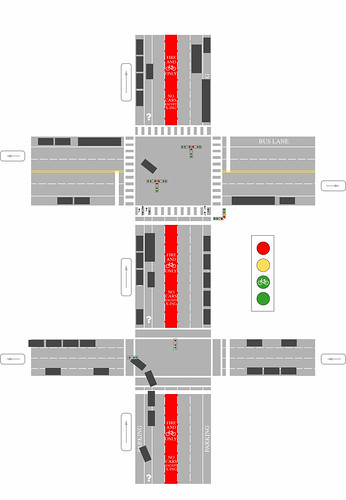Bike Lane Solution. (Please right-click image, then view Large.) Explanation below.
Image by ddartley
**To see essential details, right-click image, then view "large."**
The text below is mostly from 2007, before NYC had begun experimenting with new bike lane designs, yet many of the new bike lanes from 2008-10 still suffer many of the same problems that this design addresses.
This is an idea for a bike lane for a one-way NYC Avenue. (There is also an alternative, less-preferred design at www.flickr.com/photos/10798592@N08/1414440539/. Click on "all sizes.")
The lane marked above with "?" represents a typical NYC Class 2 bike lane on a typical NYC one-way avenue.
Notice how on every block, the Class 2 lane suffers serious obstructions and hazards created by vehicles parked, parking, standing, or turning, and also by pedestrians. These conditions, and the frequency with which they occur as depicted in the graphic, are very common in NYC, 24-7-365. Sometimes, they render bike lanes nearly useless.
*The red lane in the middle of the avenue is a solution.* It's a *bike-and-fire-only* lane. (I only suggest it would work on one-way avenues. I don't claim the design would work on two-way streets.) It's as wide as all the other car lanes. Human-powered vehicles and emergency vehicles are allowed to travel in it.
By placing the bike lane in (or near) the middle, CYCLISTS ARE SPARED THE HAZARDS THAT CONSTANTLY APPEAR ON THE EDGE OF THE ROAD. They are also made more visible to motorists. They avoid vehicles parking, stopping, and standing, and they avoid pedestrians blindly stepping into the lane, or using the lane to move food carts/hand trucks, etc. Cyclists (and pedicabs) are given more room than they currently are in most Class 2 lanes, which are dangerously narrow--very often cyclists have to weave into car lanes to overtake one another. (Currently, cars are given room to overtake one another, so why shouldn't human powered-vehicles? There are certainly enough of them now.)
For traffic controls, there are BIKE-SPECIFIC green lights at ALL sides of all intersections. They give cyclists time to safely enter the lane from a side street, or safely exit the lane, before the cars around them start moving. To exit the red lane while cars are moving with a green signal, cyclists would have to cross car lanes, but the increased awareness of bikes this design would provide would mitigate that hazard. And of course, exiting cyclists could avoid that hazard altogether by simply stopping at a *green* light (the width of the lane would allow them to do that without impeding anyone), and waiting through the signal cycle till they get a "bike green." ***Please note--this is only one of two alternatives--the other, which I don't like as much, uses "bike boxes" instead of bike-only green lights.***
This design also accomplishes the worthy, and proven-often-harmless act of taking surface area away from cars, but much more cheaply than re-building entire avenues. (Such complex rebuilding would be necessary for some avenues, but this is another option that should be considered.)
This lane is NOT physically separated. Rather, it prominently, and repeatedly displays the text, "NO CARS EXCEPT X-ING," and "BIKE AND FIRE ONLY.", and/or other text / icons. It is also colored differently from the rest of the road bed.
Here is the part that people think is crazy: Motorists would be allowed to cross the lane, but not stay in it. I think that with clear and highly visible road markings, most motorists would obey the rule.
If this design seems unrealistic now, I submit that that's only because there might not be enough cyclists yet to keep the red lane full enough of bikes to keep cyclists on motorists's minds.
Below, more rambling thoughts:
This center bike lane would create a sort of "bike thoroughfare" or "bike highway" for extended travel on a one-way Avenue like those in most of Midtown Manhattan. It's a lane in or near the MIDDLE of a one-way avenue (not on the side), colored and marked very visibly so that it's clear to motorists that at all times, it's only for emergency vehicles and human powered vehicles (HPVs). Motorists may cross it when needed, but not travel in it. (If people worry that THAT's unrealistic as far as self-enforcement, just look at the ONE good thing about Class 2 lanes--yes, motorists abuse them 99 different ways, but generally, they know not to DRIVE in them. And that's with just dinky little white lines!) To allow human-powered vehicles time to get into or out of the lane (from or to cross streets), at every side of every intersection, HPVs would have their own stop stripe, out ahead of the the stop stripe for cars (both on the Ave. AND on side streets).
Thursday, February 21, 2013
Cool Graphic Design Classes Nyc images
Subscribe to:
Post Comments (Atom)
No comments:
Post a Comment